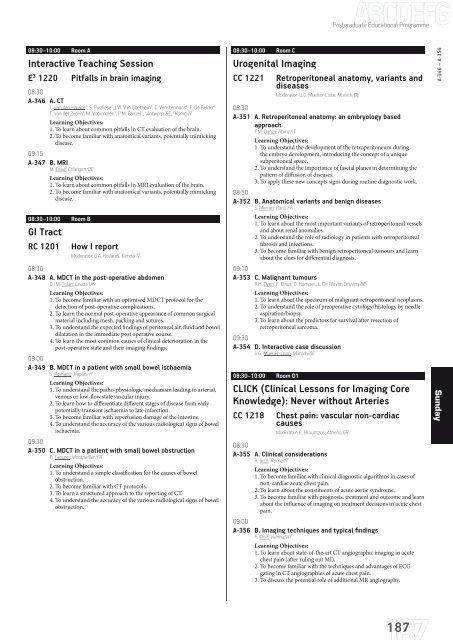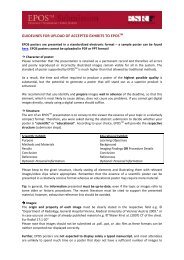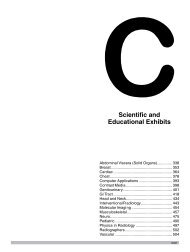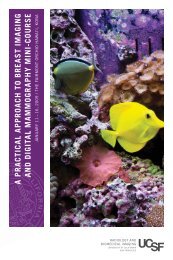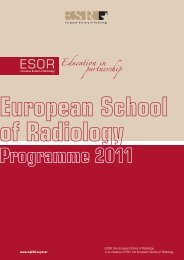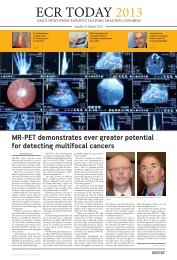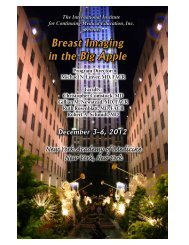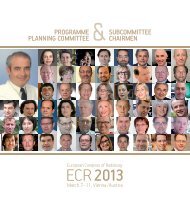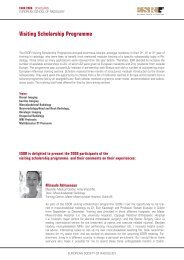ECR 2013 â Final Programme - myESR.org
ECR 2013 â Final Programme - myESR.org
ECR 2013 â Final Programme - myESR.org
- No tags were found...
You also want an ePaper? Increase the reach of your titles
YUMPU automatically turns print PDFs into web optimized ePapers that Google loves.
Postgraduate Educational <strong>Programme</strong>08:30–10:00 Room AInteractive Teaching SessionE³ 1220 Pitfalls in brain imaging08:30A-346 A. CTL. van den Hauwe 1 , S. Pugliese 2 , J.W. Van Goethem 1 , C. Venstermans 1 , F. De Belder 1 ,T. van der Zijden 1 , M. Voormolen 1 , P.M. Parizel 1 ; 1 Antwerp/BE, 2 Rome/ITLearning Objectives:1. To learn about common pitfalls in CT evaluation of the brain.2. To become familiar with anatomical variants, potentially mimickingdisease.09:15A-347 B. MRIM. Essig; Erlangen/DELearning Objectives:1. To learn about common pitfalls in MRI evaluation of the brain.2. To become familiar with anatomical variants, potentially mimickingdisease.08:30–10:00 Room BGI TractRC 1201How I reportModerator: G.A. Rollandi; Genoa/IT08:30A-348 A. MDCT in the post-operative abdomenD.J.M. Tolan; Leeds/UKLearning Objectives:1. To become familiar with an optimised MDCT protocol for thedetection of post-operative complications.2. To learn the normal post-operative appearance of common surgicalmaterial including mesh, packing and sutures.3. To understand the expected findings of peritoneal air, fluid and boweldilatation in the immediate post operative course.4. To learn the most common causes of clinical deterioration in thepost-operative state and their imaging findings.09:00A-349 B. MDCT in a patient with small bowel ischaemiaS. Romano; Naples/ITLearning Objectives:1. To understand the patho-physiologic mechanism leading to arterial,venous or low-flow state vascular injury.2. To learn how to differentiate different stages of disease from earlypotentially transient ischaemia to late infarction.3. To become familiar with reperfusion damage of the intestine.4. To understand the accuracy of the various radiological signs of bowelischaemia.09:30A-350 C. MDCT in a patient with small bowel obstructionP. Taourel; Montpellier/FRLearning Objectives:1. To understand a simple classification for the causes of bowelobstruction.2. To become familiar with CT protocols.3. To learn a structured approach to the reporting of CT.4. To understand the accuracy of the various radiological signs of bowelobstruction.08:30–10:00 Room CUrogenital ImagingCC 1221 Retroperitoneal anatomy, variants anddiseasesModerator: U.G. Mueller-Lisse; Munich/DE08:30A-351 A. Retroperitoneal anatomy: an embryology basedapproachF.M. Danza; Rome/ITLearning Objectives:1. To understand the development of the retroperitoneum duringthe embryo development, introducing the concept of a uniquesubperitoneal space.2. To understand the importance of fascial planes in determining thepattern of diffusion of diseases.3. To apply these new concepts signs during routine diagnostic work.08:50A-352 B. Anatomical variants and benign diseasesS. Merran; Paris/FRLearning Objectives:1. To learn about the most important variants of retroperitoneal vesselsand about renal anomalies.2. To understand the role of radiology in patients with retroperitonealfibrosis and infections.3. To become familiar with benign retroperitoneal tumours and learnabout the clues for differential diagnosis.09:10A-353 C. Malignant tumoursR.H. Oyen, F. Claus, D. Hompes, L. De Wever; Leuven/BELearning Objectives:1. To learn about the spectrum of malignant retroperitoneal neoplasms.2. To understand the role of preoperative cytology/histology by needleaspiration/biopsy.3. To learn about the predictors for survival after resection ofretroperitoneal sarcoma.09:30A-354 D. Interactive case discussionU.G. Mueller-Lisse; Munich/DE08:30–10:00 Room D1CLICK (Clinical Lessons for Imaging CoreKnowledge): Never without ArteriesCC 1218 Chest pain: vascular non-cardiaccausesModerator: E. Brountzos; Athens/GR08:30A-355 A. Clinical considerationsR. Iezzi; Rome/ITLearning Objectives:1. To become familiar with clinical diagnostic algorithms in cases ofnon-cardiac acute chest pain.2. To learn about the constituents of acute aortic syndrome.3. To become familiar with prognosis, treatment and outcome and learnabout the influence of imaging on treatment decisions in acute chestpain.09:00A-356 B. Imaging techniques and typical findingsF. Wolf; Vienna/ATLearning Objectives:1. To learn about state-of-the-art CT angiographic imaging in acutechest pain (after ruling out MI).2. To become familiar with the techniques and advantages of ECGgating in CT angiographies of acute chest pain.3. To discuss the potential role of additional MR angiography.A-346 – A-356Sunday187


